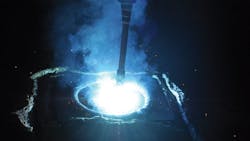Absolute Welding and Machining has been in the business of die reclamation and service-life extension for the past 20 years (originally as Absolute Welding), and working closely with welding-wire suppliers like Eureka Welding Alloys to expand the capabilities and applications of welding alloys. Over these two decades there has been steady progress in the development of welding alloys, but the application of automation technology — i.e., robots — for die repair has been minimal.
However, there has been a considerable increase in the use of robots by fabricators and assembly operations, in manufacturing projects that require welding consistency. The constantly changing welding requirements for die repair has highlighted programming limitations for those applications.
Some narrowly applicable robotic systems have been developed for forging die repair, which have worked if a die is machine prepped. This preparation can add significant time and cost to the repair project, compared to a traditional arc gouge preparation method. Factor in issues required to repair deep cracking and excessive wear areas, and it’s clear why robotic systems that use machine preparation have had limited value.
That is, until now. NeWeld – a supplier of machines and materials for brazing and welding —has combined several current technologies to develop the first versatile die-welding robot system. The proprietary NeWeld process uses CMM technology, robotics, pulse welding, custom software programming, and specially designed welding alloys to establish their system as an effective technology package.
Absolute Welding and Machining is the first third-party welding shop in the U.S. to adopt the NeWeld die-welding system, realizing the numerous practical applications and advantages.
Traditional die repair relies on high-deposition welding to fill entire impressions with specialty alloys. While the best welders can minimize the excess consumption of wire, even they cannot weld to tolerances of robotic welding. Because this “flood welding” method often requires extended precision machining as a follow-up to restore the die to specification, operations that specialize in very large forgings, or in forgings with large cavities, have frequently been prevented from taking advantage of die-welding to repair parts and extend the life of critical components.
Using the NeWeld robotic die-welding system, Absolute is seeing material consumption dropping by nearly 30%, along with more precise placement of alloys for problem areas. Not only does this material savings result in a reduced cost to the customer, it yields lower machining costs.
In addition, Absolute’s customers have reported die-life improvement following repairs using pulse-welding technologies. Pulse welding minimizes the heat-affected zone, stress input into the die, and welding dilution rates. Eureka Welding Alloys reported a 20-30% increase in die life thanks specifically to pulse welding. These increases are in addition to the die life increase already achieved with standard MIG welding with specialty alloys.
Start of a New Tradition
The NeWeld system allows a shop to use the traditional arc gouge method for die preparation. Then, a model of the prepped dies is imported into a 3D model, using NeWeld’s customized software. The 3D software is used to align the gouge model to the actual die model. Proceeding through a series of steps, the programmer develops the ideal robot weld paths, and these weld paths are then converted to programming language for the robot.
A first-time die repair will take approximately one hour to program, while repeat jobs can be completed in as little as 20 minutes.
After programing, the work passes to the robot operator, who places the preheated die onto a table and selects the proper program. The robot starts welding, stopping intermittently for the operator to check the weld and remove any slag. The operator retains the ability to make small adjustments to ensure the weld is laying down properly. One operator can oversee at least two robots while preparing gouged dies for import into the 3D software for the programmer. Essentially, one person is overseeing three separate processes. Initial tests have shown that the robot can cut welding time by 40% vs traditional flood welding.
One of the critical aspects of die reclamation and service life extension is addressing die problems with specialty alloys. Whether the problem is cracking in radii or excessive wear on forming surfaces, Absolute has alloys and heat-treatment combinations that can reduce the problem considerably, or even eliminate it. With traditional flood welding, Absolute could take a deep impression with a nub and fill it with a highly crack-resistant alloy, then cap the impression with a very wear resistant alloy. This worked well for customers, but due to welding limitations the radii on the nub could not be welded with the wear-resistant alloy. The NeWeld robotic welding system allows much finer control of alloy placement because the die is rebuilt layer by layer, and the operator can control the alloy at each layer to ensure die problems are addressed to the maximum possible extent.
These developments are creating numerous new possibilities for robotic welding systems for the forging industry. As manufacturing adheres more to global standards for productivity, product quality, and customer service, longer die life and lower costs per forging can make or break a company. Absolute Welding and Machining aims to help forgers stay competitive and improve their bottom line with the most advanced technology now available in robotic welding systems.
Dustin Wilcox is CFO and Vice President of Operations for Absolute Welding Inc., Borden, IN. Contact him at [email protected] or 812-733-4030; or visit www.absolutewelding.com
